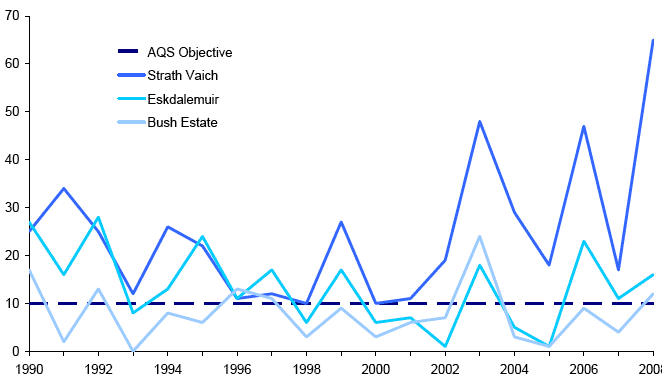Key Scottish Environment Statistics 2009
Annual publication containing summary of key statistics on environmental trends in Scotland
Air Quality
Ground level ozone concentrations: 1990-2008
Number of days exceeding 100µg/m 3 (maximum 8hr running mean)

Site 7 |
1990 |
1995 |
2000 |
2005 |
2006 |
2007 |
2008 |
|---|---|---|---|---|---|---|---|
Number of days exceeding 100µg/m 3 (maximum 8hr running mean) |
|||||||
Strath Vaich |
25 |
22 |
10 |
18 |
47 |
17 |
65 |
Eskdalemuir |
27 |
24 |
6 |
1 |
23 |
11 |
16 |
Bush Estate |
17 |
6 |
3 |
1 |
9 |
4 |
12 |
Annual mean concentration (µg/m 3) |
|||||||
Strath Vaich |
66 |
67 |
66 |
67 |
72 |
68 |
73 |
Eskdalemuir |
55 |
55 |
47 |
51 |
58 |
54 |
57 |
Bush Estate |
55 |
53 |
55 |
55 |
58 |
56 |
58 |
Ozone in the stratosphere forms a layer that protects the earth against harmful ultra-violet radiation, but tropospheric (ground level) ozone is a damaging oxidant. Exposure to high ozone concentrations can cause respiratory damage, and affects vegetation by damaging leaves and reducing yields.
Ozone is formed by a slow, complicated series of reactions from other pollutants that may be blown over from Europe. The most important man-made precursors are nitrogen oxides and volatile organic compounds produced by road transport, industrial processes and solvent use. Ozone concentrations tend to be lower in urban areas where it is converted to nitrogen dioxide by reacting with nitrogen oxides.
The Air Quality Strategy 4 objective for ground level ozone (to be met by 2005) is for the maximum daily concentration (measured as an 8-hour running mean) of 100µg/m 3 not to be exceeded more than 10 times a year. In 2008, this objective was not met at 8 of the 10 sites, including Strath Vaich, Eskdalemuir and Bush Estate.
Source: Scottish Air Quality Database
There is a problem
Thanks for your feedback